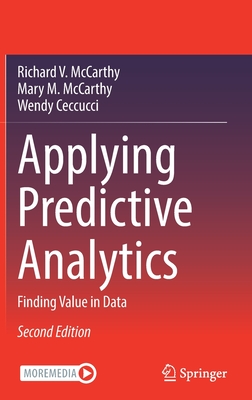图书简介
The new edition of this textbook presents a practical, updated approach to predictive analytics for classroom learning. The authors focus on using analytics to solve business problems and compares several different modeling techniques, all explained from examples using the SAS Enterprise Miner software. The authors demystify complex algorithms to show how they can be utilized and explained within the context of enhancing business opportunities. Each chapter includes an opening vignette that provides real-life examples of how business analytics have been used in various aspects of organizations to solve issues or improve their results. A running case provides an example of a how to build and analyze a complex analytics model and utilize it to predict future outcomes. The new edition includes chapters on clusters and associations and text mining to support predictive models. An additional case is also included that can be used with each chapter or as a semester project.
Chapter 1.- Introduction to Predictive Analytics.- 1.1 Predictive Analytics in Action.- 1.2 Analytics Landscape.- 1.3 Analytics.- 1.3.2 Predictive Analytics.- 1.4 Regression Analysis.- 1.5 Machine Learning Techniques.- 1.6 Predictive Analytics Model.- 1.7 Opportunities in Analytics.- 1.8 Introduction to the Automobile Insurance Claim Fraud Example.- 1.9 Chapter Summary.- References.- Chapter 2.- Know Your Data – Data Preparation.- 2.1 Classification of Data.- 2.1.1 Qualitative versus Quantitative.- 2.1.2 Scales of Measurement.- 2.2. Data Preparation Methods..- 2.2.1 Inconsistent Formats.- 2.2.2 Missing Data.- 2.2.3 Outliers.- 2.2.4 Other Data Cleansing Considerations.- 2.3 Data Sets and Data Partitioning.- 2.4 SAS Enterprise Miner™ Model Components.- 2.4.1 Step 1. Create Three of the Model Components.- 2.4.2 Step 2. Import an Excel File and Save as a SAS File.- 2.4.3 Step 3. Create the Data Source.- 2.4.4 Step 4. Partition the Data Source.- 2.4.5 Step 5 Data Exploration.- 2.4.6 Step 6 Missing Data.- 2.4.7 Step 7. Handling Outliers.- 2.4.8 Step 8. Categorical Variables with Too Many Levels.- 2.5 Chapter Summary.- References.- Chapter 3.- What do Descriptive Statistics Tell Us.- 3.1 Descriptive Analytics.- 3.2 The Role of the Mean, Median and Mode.- 3.3 Variance and Distribution.- 3.4 The Shape of the Distribution.- 3.4.2 Kurtosis.- 3.5 Covariance and Correlation.- 3.6 Variable Reduction.- 3.6.1 Variable Clustering.- 3.6.2 Principal Component Analysis.- 3.7 Hypothesis Testing.- 3.8 Analysis of Variance (ANOVA).- 3.9 Chi Square.- 3. Fit Statistics.- 3. Stochastic Models.- 3.12 Chapter Summary.- References.- Chapter 4.- Predictive Models Using Regression.- 4.1 Regression.- 4.1.1 Classical assumptions.- 4.2 Ordinary Least Squares.- 4.3 Simple Linear Regression.- 4.3.1 Determining Relationship Between Two Variables.- 4.3.2 Line of Best Fit and Simple Linear Regression Equation.- 4.4 Multiple Linear Regression.- 4.4.1 Metrics to Evaluate the Strength of the Regression Line.- 4.3.2 Best-fit model.- 4.3.3 Selection of Variables in Regression.- 4.5 Principal Component Regression.- 4.5.1 Principal Component Analysis Revisited.- 4.5.2 Principal Component Regression.- 4.6 Partial Least Squares.- 4.7 Logistic Regression.- 4.7.1 Binary Logistic Regression.- 4.7.2 Examination of Coefficients.- 4.7.3 Multinomial Logistic Regression.- 4.7.4 Ordinal Logistic Regression.- 4.8 Implementation of Regression in SAS Enterprise Miner™.- 4.8.1 Regression Node Train Properties: Class Targets.- 4.8.2 Regression Node Train Properties: Model Options.- 4.8.3 Regression Node Train Properties: Model Selection.- 4.9 Implementation of Two-Factor Interaction and Polynomial Terms.- 4.9.1 Regression Node Train Properties: Equation.- 4. DMINE Regression in SAS Enterprise Miner™.- 4..1 DMINE Properties.- 4..2 DMINE Results.- 4. Partial Least Squares Regression in SAS Enterprise Miner™.- 4..1 Partial Least Squares Properties.- 4..2 Partial Least Squares Results.- 4. Least Angles Regression in SAS Enterprise Miner™.- 4..1 Least Angle Regression Properties.- 4..2 Least Angles Regression Results.- 4. Other Forms of Regression.- 4. Chapter Summary.- References.- Chapter 5.- The Second of the Big Three – Decision Trees.- 5.1 What is a Decision Tree?.- 5.2 Creating a Decision Tree.- 5.3 Data Partitions and Decision Trees.- 5.4 Creating a Decision Tree Using SAS Enterprise Miner™.- The key properties include:.- Subtree Properties.- 5.4.1 Overfitting.- 5.5 Creating an Interactive Decision Tree using SAS Enterprise Miner ™.- 5.6 Creating a Maximal Decision Tree using SAS Enterprise Miner ™.- 5.7 Chapter Summary.- References.- Chapter 6.- The Third of the Big Three - Neural Networks.- 6.1 What is a Neural Network?.- 6.2 History of Neural Networks.- 6.3 Components of a Neural Network.- 6.4 Neural Network Architectures.- 6.5 Training a Neural Network.- 6.6 Radial Basi
Trade Policy 买家须知
- 关于产品:
- ● 正版保障:本网站隶属于中国国际图书贸易集团公司,确保所有图书都是100%正版。
- ● 环保纸张:进口图书大多使用的都是环保轻型张,颜色偏黄,重量比较轻。
- ● 毛边版:即书翻页的地方,故意做成了参差不齐的样子,一般为精装版,更具收藏价值。
关于退换货:- 由于预订产品的特殊性,采购订单正式发订后,买方不得无故取消全部或部分产品的订购。
- 由于进口图书的特殊性,发生以下情况的,请直接拒收货物,由快递返回:
- ● 外包装破损/发错货/少发货/图书外观破损/图书配件不全(例如:光盘等)
并请在工作日通过电话400-008-1110联系我们。
- 签收后,如发生以下情况,请在签收后的5个工作日内联系客服办理退换货:
- ● 缺页/错页/错印/脱线
关于发货时间:- 一般情况下:
- ●【现货】 下单后48小时内由北京(库房)发出快递。
- ●【预订】【预售】下单后国外发货,到货时间预计5-8周左右,店铺默认中通快递,如需顺丰快递邮费到付。
- ● 需要开具发票的客户,发货时间可能在上述基础上再延后1-2个工作日(紧急发票需求,请联系010-68433105/3213);
- ● 如遇其他特殊原因,对发货时间有影响的,我们会第一时间在网站公告,敬请留意。
关于到货时间:- 由于进口图书入境入库后,都是委托第三方快递发货,所以我们只能保证在规定时间内发出,但无法为您保证确切的到货时间。
- ● 主要城市一般2-4天
- ● 偏远地区一般4-7天
关于接听咨询电话的时间:- 010-68433105/3213正常接听咨询电话的时间为:周一至周五上午8:30~下午5:00,周六、日及法定节假日休息,将无法接听来电,敬请谅解。
- 其它时间您也可以通过邮件联系我们:customer@readgo.cn,工作日会优先处理。
关于快递:- ● 已付款订单:主要由中通、宅急送负责派送,订单进度查询请拨打010-68433105/3213。
本书暂无推荐
本书暂无推荐
















